River Ai
The river Ai flows between high, forest covered, abrupt mountains, and sometimes -vertical walls. Its banks are decorated with whimsical calcareous rocks as towers, fortifications, and columns. On the slopes of the mountains there are ideal viewing areas from which the panoramic landscapes of the valley of the Ai River, rocks and cliffs are opened up before us. The river’s current is swift and frequently there are stony fords, underwater and surface boulders, and numerous cascades. During the rafting along the river Ai you will see “the Stone gate”, where the river narrows sharply and the speed of the current increases.
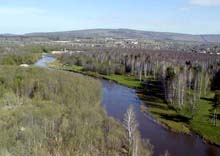 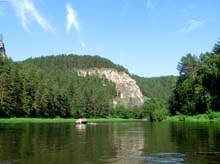 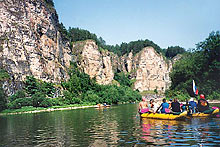
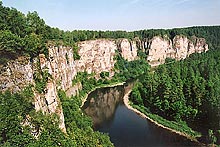 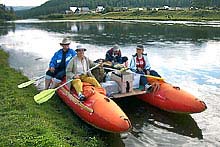 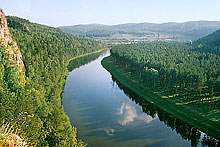
Besides you will visit the caves Kurgazak, the grotto of Fishermen (ancient burial ground) and examine the rock paintings “Pisanitsa” (from Palaeolithic times). The entire valley of the river Ai is a monument of history and nature. In the vicinity of the cave there is a thermal spring, formed together with the cave in the Devonian times.
One of the most beautiful places on the river is the stone-wall “Big Pritesy”, with a height of up to 80 metres and extending more than a kilometre.
As usual tourists stop their travel near the village Sikiyaz-Tamak, where one can visit the unique Sikiyaz-Tamak cave town. The cave complex is situated on the right bank of the river Ai on the mountain slopes. This amazing complex includes 43 caves differing in size and shape - among them are caves, grottoes, cliff awnings, karst arcs and bridges, and many other types. The biggest being: grotto “Tanchevalnyi” (Dancing grotto), caves “Caminnaya”, “Vestibule” and “Scvoznaya” (“Through passage”). The caves were discovered in August 1995, by a group of archaeologists (S.Baranov and V.Yurin). The united archaeological expedition, which had started to work on this historic site, had already made a number of sensational discoveries. Signs of life of primitive man and remains of extinct animals have been found in 15 of the caves. During the archaeological investigations cultural layers, which belong to different historical epochs were found. These were the upper Palaeolithic, Mesolithic, Neolithic, Neolithic and the bronze epoch of the early Iron Age and the Middle Ages. They found labour tools, household goods, weapon and jewellery, pieces of ceramics and many thousands of bones from different animals, including the so-called “mammoth”. In the distant grotto of Sisoev’s cave the scientists discovered an underground sanctuary with the remnants of cave bears and a place where ancient men from the Urals worshiped unknown gods.
If you have time you can continue your rafting up to the village Lakly and visit the cave “Laklynskaya”. Among the caves, situated in the territory of Bashkiriya, the cave “Laklynskaya” is one of the largest (height of the main hall is approximately 20 m and a width of 50 m) with a length of about 320 metres. Its entrance is situated 40 metres above the river Lakly – a tributary of the river Ai. When the temperature outside is +30 OC, in the cave it will be about 0 OC. Even at the cave’s entrance the ice doesn't usually melt. It is famous for its unique calcite formations in the form of a bowl or an ornamental ball. The slopes of the mountain, where the cave is situated, are covered with wild cherries.
Our tours:
Rafting on the river Ai
 
|

